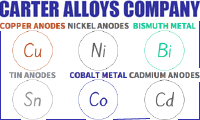
Curated with aloha by
Ted Mooney, P.E. RET

The authoritative public forum
for Metal Finishing 1989-2025

-----
Ortho phosphate to pyro phoshate conversion
I'm new to the electroplating industry and would appreciate the assistance of some experienced professionals and/or any academics who may have any insight into stabilizing or regenerating a copper pyrophosphate/tetrapotassic pyrophosphate plating bath used in a sequential plating process. Every two or three months, the bath must be decanted to allow the manual removal of a sky blue sludge that is referred to as "ortho phosphate".
I remember reading a reply from Pune, Mah., India to another letter (#2358) that originated in Poland. In the reply, reference was made to having converted ortho phosphate to pyro phosphate because no local supplier for the "pyro" could be found.
This makes me wonder if there isn't some commercially acceptable technique to reconstitute the lost "pyro"from this sludge. Or, even better, if there isn't an "additive" available that would inhibit the reaction that results in the formation of the ortho phosphate that would not interfere with the copper plating onto the steel substrate. This loss of copper pyro and tetrapotassic pyro phosphate is a significant cost of doing business. Surely someone has made significant progress in this area by now. We are very diligent about controlling temperature, current, fluid density, etc., but the sludge still forms at different sites in the bath. Its formation is apparent on the copper anodes.
Does it help if the anodes are wiped clean periodically? I.e. is it self propagating? Others have noted the formation of the sludge upon adding room temperature water to adjust the bath for evaporative losses. Would preheating the make-up water help?
Any suggestions or authoritative references on dealing with this problem would be very much appreciated.
Thank you.
Donald R. StewartScottsburg, Indiana, USA
2001
2001
I worked with pyro copper for 5 years, plating printed wiring boards, and yes, that's what the pyro baths did for us too. It was quite a mess, and very expensive.
I don't believe anyone ever was able to do better that what you are doing. How about looking into some of the proprietary cyanide free baths sold today? Are you adding all chemicals according to the best practice discussed in the general textbooks for formulation? The best you can do right now is run the bath at recommended levels, anodes, etc., and live with the problem.

Tom Pullizzi
Falls Township, Pennsylvania
I have been searching the forums for information about pryo copper plating. This thread has come close to answering a question that our local suppliers cannot.
The question is: The sky-blue sludge referred to by the original poster, is that in fact copper orthophosphate?
We believe from our own tests (our supplier doesn't test for this) that our orthophosphate level is 61 g/l (This test is done by measuring the specific gravity of the solution when all salts are in the acceptable range).
We have for the first time in five years found a blue sludge in the bottom of the tank. A sample of the solution, cooled to room temperature, becomes "jelly like" and cloudy.
These we believe to be signs of orthophosphate formation. I would really just like to know for sure the answer to the above question. A confirmation that what the original poster believed was orthophosphate is actually so.
- Auckland, New Zealand
2007
adv.: Supplier of Copper Anodes, Nickel Anodes, Bismuth Metal, & Other Metal Products for Industry & The Arts

Q, A, or Comment on THIS thread -or- Start a NEW Thread